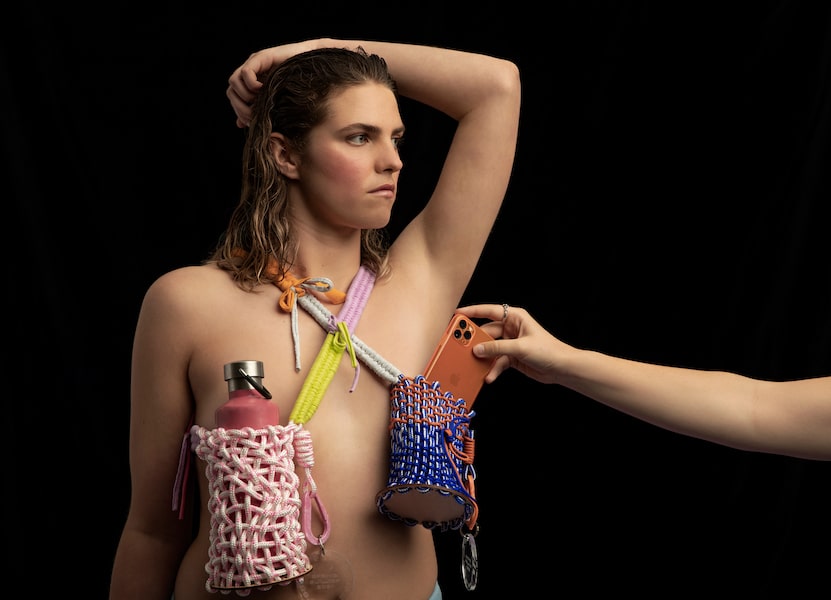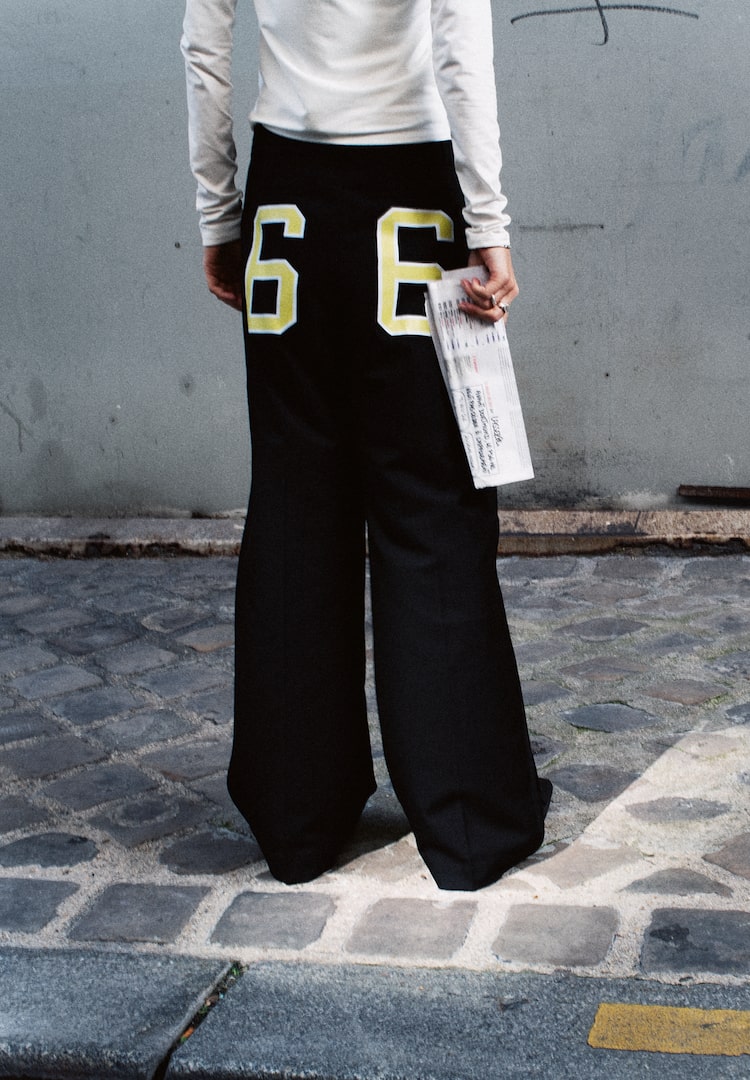Melbourne designer Lilli McKenzie is using the human body as “a loom for weaving upon”
PHOTOGRAPHY BY LILLI WATERS FOR LILLI MCKENZIE
WORDS BY IZZY WIGHT
“I used my own arms and legs to make gloves and socks, and got my housemate to stand still for hours while I weaved random yarn onto her.”
Following the height of the fashion industry’s DIY renaissance, we have a new appreciation for the craft behind design. Techniques like applique stitching, crochet and embroidery are enjoying a well-deserved moment in the sartorial sun.
Similarly, more and more designers are recognising the long-held beauty in weaving, a practice that finds its roots in many traditional cultures, and has held significance within First Nations communities for thousands of years. Here in Australia, the artisanal process is deeply rooted in the traditional knowledge of our First Peoples that passes from generation to generation. You can read more about its rich history here.
Looking for more ways to procrastinate? We’re with you. Come on over to our Fashion section.
For Melbourne-based designer and recent fashion graduate, Lilli McKenzie, weaving is a skill she learnt at university through an intensive summer unit. Falling in love with the meticulous detail and careful nature of the craft, she took to using her body – and her housemate’s – as a kind of “loom to weave upon”.
Using upcycled yarn in shades of soft lavender, fuschia and luminous lime green, Lilli’s handwoven designs are a vibrant interpretation of traditional practices. In the glow of her newfound success (following her debut at this year’s Melbourne Fashion Week), Lilli tells us what’s next for her eponymous label.
Tell us about you. What’s your fashion background?
View this post on Instagram
Hi, I’m Lilli! I guess I would say I’m the designer and creative director of Lilli McKenzie. I’m currently based in Naarm/Melbourne, but I’m most well-known for living in my own world. I’m a recent graduate of the Bachelor of Fashion Design (Honours) at RMIT. My current fashion design practice is a culmination of the last four years of studying, and a lifetime of adoring resourceful and sustainable design.
Outside of my own brand, I also work for HoMie, a not-for prof streetwear label based here in Melbourne. In my role as a designer for the Reborn range, I have a lot of creative freedom to redesign and up-cycle HoMie’s damaged garments or headstock, donated by partnering brands like Champion.
How did the label get started? Talk us through the process and the challenges.
I first experimented a lot with weaving onto the human body. I used my own arms and legs to make gloves and socks, and got my housemate to stand still for hours while I weaved random yarn onto her. This proved to be very painstaking for everyone involved. I now have a much simpler system of making, where I am able to weave these form-fitting stretch garments straight onto the mannequin.
How would you describe Lilli McKenzie to someone who’s never seen it before?
View this post on Instagram
Colourful, comfortable, fun and all handwoven using recycled materials. Need I say more?
What were you trying to achieve from the project at the time? How has this evolved and what are you trying to communicate through the brand now?
I honestly had no idea what this project was going to look like at the beginning of 2021. Funnily enough, I didn’t know how to weave at that point. I took a weaving intensive in summer to make up for uni credits! One of the activities I was drawn to was this scavenging exercise where we were asked to weave a swatch using only random objects we found in our backyard.
I love the idea of being resourceful in fashion design, and that in theory, you can turn any old object into something new through weaving. After much experimenting with different recycled materials and methods, my designs now mostly consist of yarn sourced by the Ministry of Yarn. The brand takes factory t-shirt offcuts and turns them into yarn.
Another collaborator was the Precious Plastics company in Melbourne, they helped in creating the custom carabiners made from recycled plastic. All materials were actually sourced within Victoria, including the rope which was all offcuts and deadstock!
What are you most proud of in your work on your label?
I’m most proud that I’ve been able to combine all the elements of fashion that are important to me as a designer: sustainability, comfort and flare. I’m also proud of myself for learning to embrace my flaws.
When you’re weaving for hours on end, it’s very easy to lose track of a stitch. I often get super obsessive after I realised I’ve made a mistake. The fact is that what I’m trying to achieve here isn’t perfect, and the reality is mistakes are a reminder that each piece is 100 per cent handcrafted by moi.
What do you wish you knew when you started?
View this post on Instagram
Trust the process! There were a lot of times when I felt I was going nowhere with my project and kind of lost a bit of faith. Spoiler: it all worked itself out. I also wish I wasn’t so hard on myself and I didn’t diminish the work that I achieved.
What about the Australian fashion industry needs to change?
The unfortunate reality is that it’s super expensive to source materials and manufacture within Australia. This means some brands have to sacrifice their sustainability targets in order to keep their business affordable to their consumers.
I think fashion production within Australia needs to be more accessible and affordable for makers and consumers, so we can continue to support our local economy without breaking the bank. I’m really not sure how that will happen exactly, but it’s great to see so many Australians becoming way more environmentally conscious and choosing to support local creatives.
Dream Australian collaborators?
I would love to get Flex Mami wearing some Lilli McKenzie pieces. Call me.
Who is in your wardrobe right now?
I’m the queen of comfort, so my go-to pieces summer pieces are from Suku and my favourite pair of pants at the moment are the velvet track pants from RampTrampTrampStamp.
How can we buy one of your pieces?
I’m currently working on a few different collaborations with other creatives. My goal in the near future is to make my pieces available to be purchased, I would love love love to see my pieces hit the streets. I’m always open to discussing custom pieces and collaborations, just send me a message on Instagram or shoot me an email!
Anything else to add?
It’s an exciting time to be a fashion designer in Australia. I think a lot of designers are getting international recognition and big names associated with their brands. Previously there’s been a huge push for young and up-and-coming designers to travel to Europe or the States, so this growing number of local designers makes me feel super hopeful about my opportunities here in Melbourne.
Discover more of Lilli’s intricate design work here.















